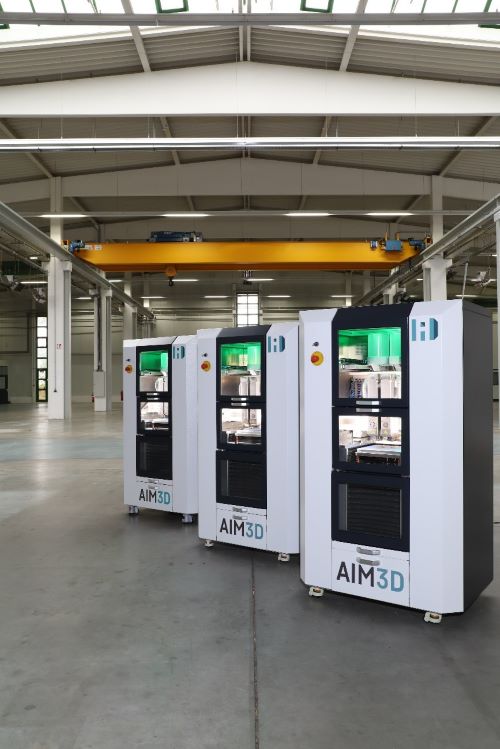
Multi-material 3D printer ExAM 255
The Chair of Microfluidics at the University of Rostock is working together with Stenzel MIM Technik GmbH (Tiefenbronn near Pforzheim) on a project to print a 3D metal injection moulding (MIM) tool. The basis of the development is the use of AIM3D's CEM technology with an ExAM 255 system. The ExAM 255 system combines a high precision of 3D components with high build speeds for additive manufacturing (AM). Compared to a conventional approach in machining, the use of an AM process to produce a MIM tool reduces the total production time from around 8 weeks to approx. 5 days.
As part of a project funded by the German Federal Ministry for Economic Affairs and Energy (BMWi), the 3D printed MIM tool is a cooperative development between the Chair of Microfluidics (LFM) at the University of Rostock and Stenzel MIM Technik GmbH. The duration of the project is from April 2021 to October 2023. The basis for the process and application is the use of the CEM technology from AIM3D, implemented on an ExAM 255 system. The project represents the current state of the art in 3D metal printing.
3D tool with near-contour cooling for metal injection moulding (MIM)
The goal of the joint project between the University of Rostock and Stenzel MIM Technik was to use 3D printing to manufacture a tool for metal injection moulding with near-contour cooling. In 3D printing, near-contour cooling can be incorporated as a so-called functional integration with helical channels directly in the tool. In other words, it is not embedded as inlets, as is the case with larger tools. The goal of any near-contour cooling of injection moulds made out of metals or polymers is to significantly reduce the cycle time. The principle of near-contour cooling is to guide coolant fluids through near-contour cooling channels with low cross-sections. They cool the component already during the cycle. This leads to a faster demoulding process, which significantly shortens the cycle. The complex geometry of the helical cooling channels is created with the help of CAD technology using simulation models that are based on the "needs" of the component. Long-term experience shows a reduction in cycle time by around 20%, depending on wall thickness and size.
As an integrated component solution, 3D printing offers the advantage of a "one-shot technique" as a functional integration compared to mould-bound processes. The application example therefore demonstrates an opportunity to drastically reduce the "time-to-market". The aim of the cooperation project is to develop a new process chain for the cost-efficient and rapid production of MIM tools. Up until now, time periods of up to eight weeks have been needed to produce a conventional metal injection mould. With 3D metal printing, the provision time of a MIM tool can be reduced to about five days.
Details of tool development at the University of Rostock
As part of the cooperation, an optimised 3D model of the tool was initially developed using CAD and simulation tools. This data was then transferred to the ExAM 255 CEM system, together with the necessary process parameters. A so-called "green part" is then 3D printed. Afterwards, the part is sintered in a multi-stage process to produce the final material properties. With this process, complex metallic components can be rapidly produced after the necessary debinding and sintering steps. At the same time, the CEM process allows for the control of the volumetric shrinkage associated with sintering. The resulting mould has a cavity. The component consists of a thick-walled part with thin fins. These fins cannot be produced without near-contour cooling, as they are difficult to demould. Stenzel MIM Technik hopes to achieve a significant reduction in cycle time for this component by up to 70-80%. However, injection moulding trials for testing are still pending.
Material diversity with the ExAM 255
The multi-material 3D printer ExAM 255 can be used with a variety of different materials (metals, plastics, ceramics) and with various processes (hybrid components). Compared to powder bed processes or even other 3D printing processes that use filaments, systems using the CEM process achieve tensile strengths that come close to classic thermoplastic, mould-bound injection moulding. The price advantage of 3D printing is particularly striking when commercially available granulates are used instead of filaments. When granulates are used, the CEM process leads to cost savings of up to a factor of 10.

Process chain for the production of a MIM tool

MIM tool produced with the CEM process
AIM3D GmbH
Industriestraße 12
D-18069 Rostock
Germany
Phone: +49 (0) 381 / 36 76 609-0
Email: kontakt@aim3d.de
Website: www.aim3d.de/
Management board:
Dr.-Ing. Vincent Morrison (CEO)
Clemens Lieberwirth (CTO)
Daniel Selck (CSO)

 iConnectHub
iConnectHub
 Login/Register
Login/Register Supplier Login
Supplier Login



























